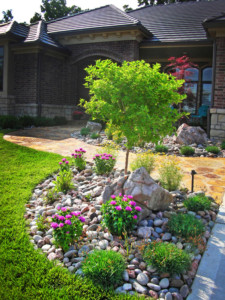One of the most enjoyable treats for home gardeners in Kansas City is the arrival of Spring weather that calls all landscaping chores in KC to the starting gate. Sometimes, after those landscaping activities begin and summer plants can go into the ground (like many other Midwestern cities), Kansas City experiences some truly dramatic weather changes during the seasonal changes. Planning and knowing the right lawn maintenance schedule can be tricky in Kansas City but you can meet many of these challenges by following a few simple pointers.
When considering weather impact in KC, gardeners sometimes remember the dates their parents or grandparents typically put vegetables or annuals into the ground. Things have changed, though. Today, KC weather has mellowed enough that perennials that once couldn’t thrive here now can and annuals that wouldn’t live through a cool spring now flourish. Climate research shows that Kansas City, once a part of the US Department of Agriculture’s hardiness Zone 5, can now easily support Zone 6 flowers, fruits and vegetables thanks to winters that aren’t as bitter as they once were. Flowering shrubs like crape myrtle and even more exotic perennials such as passion flower can handle the winter time temperatures that rarely drop below zero degrees Fahrenheit.
Typical first and last frost dates have changed a bit over the past 25 years as well. Today, the average growing season for Kansas City is generally just under six months, or approximately 185 days between April 16 and October. Gardeners who plant before March 31 or after October 31 are almost guaranteed to run into frost problems that will kill seedlings or other delicate plants not ready to handle the harsher weather when landscaping Kansas City.
But nearly every gardener has at one time or another lost a newly-planted shrub, perennial or annual to a completely unexpected frost or freeze. Even if she plants during the typically “safe” time period following the nearly guaranteed frost-free date, there’s no completely foolproof guarantee that cold weather won’t impact her plants. That’s when she needs to take some steps to protect plants already in the ground. Insulation such as sheets or burlap placed over plants help keep the air temperature around the plants warm enough to prevent frost damage. If plants are very young, it’s a good idea to put tomato cages or cans over them first so that the fabric won’t crush them.
Kansas City residents also know that hail and high winds are an expected part of spring weather in the Midwest. Hail in particular can do some serious damage to seedlings and even to more established plants. For example, large-leafed plants like Hosta can become so pock-marked with tears and holes that they’ll have trouble recovering after being hit by hail. Smaller plants can be completely destroyed.
When hail hits a gardener’s plants, there are some things he can do to help rejuvenate those that aren’t so seriously damaged that they must be replaced. Hail damage that occurs early in the season can be mitigated by adding extra fertilizer to the plant to strengthen their roots. Late-season hail storm damage can be relieved with the addition of extra mulch to help the plant or shrub survive the winter.
Wind, surprisingly, can be as much of a danger to landscaping in KC to young plants as it is to trees. Everyone’s familiar with the damage wind does to tree limbs, but it can “burn” younger shoots near ground level as well. If high winds damage perennials in particular, a trim can be very helpful. Often the top few inches of the plants suffer the most, so taking those top inches off will give the rest of the plant a chance to recover. When making plans for your landscaping schedule in Kansas City, it’s best to remember to expect the unexpected, plan accordingly and react quickly to the huge swings to keep your yard on track this season.




